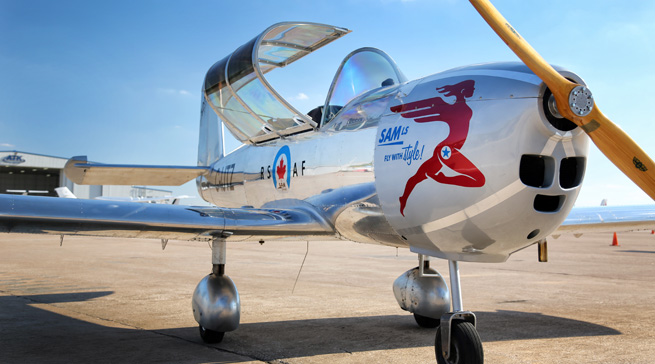
The pint-size SAM LS Light Sport aircraft looks like a mini warbird and is a joy to fly low and slow. With a nose that slopes down and the front seat located in front of the wing, the SAM LS offers excellent forward visibility on the ground and in the air, and the canopy can be removed by releasing three pins for an open-cockpit experience.
The controls don’t get mushy in slow flight, and a buffet provides ample warning of approaching stalls. Published specs say the aircraft stalls clean at 49 mph and with full flaps at 42 mph, but on this flight, the aircraft stalled about three mph slower for each. In uncoordinated stalls, it showed no tendency to spin.
Pilots will notice thicker-than-normal trailing edges on the ailerons, which were modified for aerodynamic balance. Flying hands off, the aircraft had no tendency to bank left or right and rolled crisply into and out of steep 45- to 60-degree bank turns.
During a high approach to landing, the SAM LS slipped easily with 10 degrees of flap, although that is not a limitation. (The aircraft’s electrically actuated Fowler flaps extend to 35 degrees.)
The SAM LS is easy to enter—the pilot must step up onto the wing and then over the fuselage onto the seat or floorboard, like an Ercoupe—but it is comfortable once seated inside the 26-inch-wide cabin. The throttle is located on the left, just in front of the leather-covered armrest, making it natural to rest the hand on the control. SAM Aircraft Founder Thierry Zibi said he is awaiting an FAA audit before selling the aircraft in the United States as an LSA. Zibi said it should take six to eight months to complete the process.
Email [email protected]
DETAILS: Powered by a 100-horsepower Rotax 912 ULS, the SAM LS will cruise at 125 mph burning five gallons per hour if fitted with a composite two-blade Sensenich propeller. On AOPA’s flight, however, the SAM LS cruised at 115 mph with a wooden prop. Its best rate of climb and final approach speeds are 70 to 75 mph.
With standard equipment, including the Dynon SkyView and leather seats, the SAM LS costs $131,000. A kit version sold in Canada costs $23,200. The aircraft comes standard with one of three paint schemes: polished aluminum, blue and white to look like the T–28 Trojan, or yellow and black to look like the AT–6.
Video: Fly along in the Sam LS
Star sightings: NBAA convention built on hope
By Alton K. Marsh
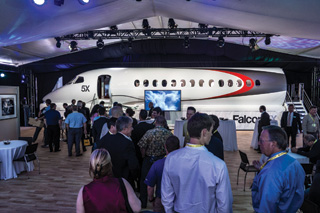 It wasn’t the largest attendance ever, but what the recent NBAA convention in Las Vegas lacked in people was more than made up for in hopes for an economic turnaround. Final attendance numbers for the National Business Aviation Association gathering were 25,425—about the same as 2012 but 7,663 fewer people than in 2006; 5,918 less than in 2007; and 5,386 fewer than 2008. Still, it had what keeps a large, worldwide media contingent happy—at least one big announcement, a strong Chinese presence, star power, and a company dominating the convention with marketing ploys.
It wasn’t the largest attendance ever, but what the recent NBAA convention in Las Vegas lacked in people was more than made up for in hopes for an economic turnaround. Final attendance numbers for the National Business Aviation Association gathering were 25,425—about the same as 2012 but 7,663 fewer people than in 2006; 5,918 less than in 2007; and 5,386 fewer than 2008. Still, it had what keeps a large, worldwide media contingent happy—at least one big announcement, a strong Chinese presence, star power, and a company dominating the convention with marketing ploys.
Big news this year was the anticipated announcement of the $45 million Dassault 5X, which will carry up to 16 passengers at Mach 0.90. Chances are passengers will all be able to walk the airplane’s aisle without crouching over, since the cabin is six feet, six inches high. First flight is planned by the end of 2015.
As was the case in several past NBAA conventions, delegations of Chinese aviation officials attended, some of them giving press conferences to describe the long march to China’s aviation future. Jackie Chan provided some of the movie star power, making appearances at Embraer’s booth and press conference, while Iron Maiden rocker Bruce Dickinson opened for Eclipse press conferences.
Nextant, now quietly trouncing Beechcraft in a race to overhaul the Beechjet/Hawker 400 fleet with engines, winglets, and avionics, said it would begin retrofitting King Air C90s, too. Beechcraft officials had successes of their own to talk about, having previously announced a huge order for new King Air 350i twin turboprops to charter company Wheels Up. Wherever convention goers looked, there was a Wheels Up sign or another attendee wearing a Wheels Up hat.
Email [email protected]
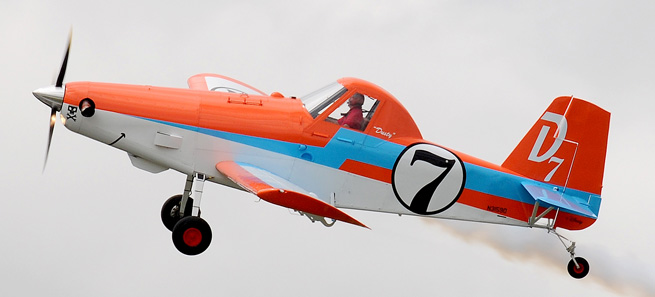
Making Dusty fly
A worn-out Air Tractor becomes a star
By Dave Hirschman
The real-life story of a worn-out Air Tractor’s transformation into one of the most recognizable airplanes on the planet is as unlikely as the fictional Dusty Crophopper’s movie quest for air racing glory.
As Disney’s animated movie Planes was about to open at U.S. theaters during summer 2013, the actual Air Tractor that would represent the movie character at airshows and events around the country was in pieces at an ag strip in south Texas.
That’s when Rusty Lindeman, owner of Rusty’s Flying Service, in D’Hanis, got a call from Disney. The giant studio wanted an actual airplane that matched Dusty in every detail to appear at airshows in the United States and Canada, and the first one was at Jones Beach in New York City in less than six weeks.
Disney had already approached Air Tractor, the manufacturer in Olney, Texas, but the company was too busy and had a long backlog. Air Tractor officials suggested Lindeman, owner of a 10-airplane flying service.
Lindeman wanted to say yes, but he couldn’t afford to take a working airplane out of service for a summer movie promotion. A working turbine ag airplane can bring in more than $400,000 in revenue during a season, and Disney wasn’t paying anywhere close to that. Still, Lindeman wanted to find a way.
“This was a chance to get kids interested in flying,” said Lindeman, 60, a tall, weathered, 15,000-hour ag pilot. “It had the potential to be positive for our industry. If that was the case, it was worth my time to do it. But I couldn’t afford to pull a working aircraft off the line.”
Lindeman had a 1988 Air Tractor fuselage with 12,000 ag hours in his hangar, and he found a used set of wings and tail surfaces. He knew he could paint the airplane himself, so that wouldn’t be an issue.
“We can fix or build just about anything at my place,” he said. “My sheet metal boys went to work on the fuselage. We were working night and day, but it quickly became obvious that we were going to need some serious help to meet the deadline. I called Air Tractor and told them I was in trouble. They said, ‘No, you’re not,’ and sent three of their mechanics and all the parts we needed.”
Lindeman and his crew painted the airplane in Dusty livery. “We only had a cartoon drawing and some paint chip numbers to go by, not detailed painting instructions,” he said. “We repainted the number seven on the side three times when they wanted it bigger or smaller. Every time I’d ask, ‘You realize this is paint we’re talking about? It’s not a sticker.’”
All spray equipment was removed from the airplane, and the hopper was converted to carry additional fuel. The engine is a Pratt & Whitney PT6A-20 of 550 horsepower from RT Turbines. The airplane is about 20 mph faster than a standard 400A, and its cruise speed is about 165 mph. “It’s real light on the controls and very responsive,” Lindeman says.
The cockpit instrumentation is stripped to the minimum, and Lindeman uses a Garmin aera 510 for navigation. The standard “cool seat” is installed, along with a heater. “I typically fly at 10,000 or 11,000 feet when I’m going cross-country because it’s so much more fuel efficient,” Lindeman said.
His longest leg was a nonstop 6.4-hour trek from San Diego to San Antonio, Texas. A tailwind pushed groundspeeds beyond 190 mph, speeds seldom seen in most ag airplanes.
Going to big events has required Lindeman to fly in busy airspace that ag pilots normally avoid. “We really don’t talk on the radio all that much,” he said. “That part has been an adjustment for me.”
The airplane stayed on the road all summer and into the fall, with events on both coasts, as well as in Canada and AOPA Summit in Fort Worth, Texas. Lindeman typically airlines home between promotional appearances.
Dusty has returned to south Texas for the winter, however, and Lindeman and Disney are considering another tour next summer timed to the release of Planes II, a sequel based on firefighting and rescue aircraft. (If it works out, Dusty may soon be sporting a set of amphibious floats.)
Lindeman said he’s been pleased at the warm receptions he’s received from fellow airshow pilots. “The airshow community has welcomed me with open arms,” he said. “They all see how good Dusty is for aviation.” At the big shows, Lindeman stands back from the airplane and watches people react. When he sees kids who are curious but too shy to push forward, he seeks them out and offers them a chance to climb on the wing and perhaps sit in the cockpit.
When Dusty flies, Lindeman says he’s astonished to see children rush forward to the crowd line. “The kids just hang on the fence,” he said. “This airplane captures their imaginations.”
Lindeman’s airshow routine is a simple series of passes up and down the runway. White smoke billows from the exhaust stacks as he does a series of tight, 180-degree “crop duster turns.” There are no loops or rolls or aerobatics of any kind. While he’s flying, a recording of Dusty’s animated voice plays on the public address system.
“To me, the flying itself is kind of boring,” Lindeman said. “I’m just going up and down the runway. But people really respond to the Dusty character and its story.”
That sank home to Lindeman when he spotted a 5-year-old boy at EAA AirVenture in Oshkosh, and encouraged him sit in the cockpit. After a few minutes of examining the instruments, the boy had a question. “He wanted to know how to make Dusty talk,” Lindeman said. “I was stumped for a few seconds, but then I came up with an answer: ‘He only talks when he’s flying.’ And that seemed to satisfy him.”
Email [email protected]
‘Live in the moment’
A photo captures the experience
By Matthew Keller
To live decisively in the moment eliminates factors that might otherwise influence a bad call.
After departing Palmer, Alaska, I took a northerly heading over the Talkeetna Mountains in my Super Cub. The plan was to drop off a client on a glacier at 6,000 feet msl. The weather was pleasant and the 45-minute flight went without a hitch. After departing the glacier I continued further northeast in hopes of ending the day at our airstrip at Sheep Mountain. I climbed to 7,500 feet to get over a ridge and took a direct route for Sheep Mountain. The GPS showed me just 35 minutes from home.
The weather was deteriorating in front of me. Weather reporting stations are not available in these mountains, and I still had more than 50 miles of mountainous terrain to cover. The problem was that I only had 1:15 minutes of fuel on board. In order to maintain my legal fuel minimums of 30 minutes, I needed to be on the ground in 45 minutes. So, I only had 10 minutes of “extra” time. Descending below the cloud deck was an option, but I knew it was a one-way trip, because my fuel situation would not allow a climb back to 7,500 feet. Descending would also force a longer flight path, as I would then need to divert through the various mountain passes. I had two choices—maintain my altitude, preserve gas, and deal with worsening weather on top; or descend below the clouds, and deal with the unknown visibility and ceiling restrictions, likely ending with a fuel shortage. Neither option gave me the warm fuzzies.
When I need to make a tough decision like this I remind myself to live in the moment. I was not out of fuel. I was not even low on fuel. Fuel was not the issue for another 45 minutes. I needed to make the correct decision for the moment, and let the future worry about itself. Trying to outclimb fickle weather, in the mountains, with a naturally aspirated engine, while operating on minimum gas could end very, very badly. On the other hand, descending legally into a known valley, to face unknown flight visibility—but with the option to land in a fuel shortage—is simply inconvenient and embarrassing. I’ll take the red face and inconvenience.
Future dilemmas tend to pollute decision-making and keep us from doing the right thing, right now. I descended above the glacier knowing that I could land on the ice and spend a miserable night if I needed to.
When I got beneath the clouds, the weather was poor, but flyable, so I continued home through the mountains, taking one mountain pass at a time and noting each area I could land. That way, if the weather got really bad, I already had a landing zone in mind. Fortunately the weather held long enough for me to arrive home with my legal fuel reserve. Remember to live in the moment, and some of those tough PIC decisions will get easier.
Matthew Keller is the owner and pilot of Blue Ice Aviation. He offers tours of Alaska in his Piper Super Cub.
Are you fit enough for the Air Force?
See how you stack up
By Alton K. Marsh
Personnel literally have been fired for flunking the standard physical exam in the U.S. Air Force. Think you could pass it? You’ll need to score at least 75 points based on your waistline measurement, a 1.5 mile run, and the number of push-ups and sit-ups you can do in one minute. If you are weak in one category, you can make it up by scoring more points in another. These combinations will score 75 points, but you may have to improve in one or more categories based on your personal situation. In mine, that waist isn’t going to be 37.5 inches anytime soon, so I’ll need to run faster or get more proficient at sit-ups and push-ups.
Email [email protected]
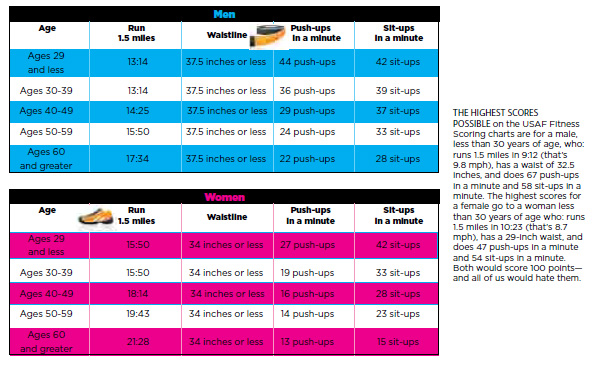
Giant dirigible in development
Worldwide Aeros, headed by Igor Pasternak, has developed a prototype of a rigid-frame airship that could grow to one capable of lifting 500 tons. The idea is to deliver massive amounts of rescue supplies to areas that have suffered catastrophic damage or are in remote battlefield locations. The craft made a controlled flight to a shallow hover at its base on the outskirts of Los Angeles in Tustin, California. Video: www.youtube.com/watch?v=OKMJ3XE-rXA
Get the haddock
Fantastic fish and chips—on the field
By Mike Collins
Craving fish and chips? Yeah, we thought so. If you’re anywhere in the Pacific Northwest, plot a course for Bremerton National Airport (PWT) in Bremerton, Washington—just across Puget Sound and about 20 nautical miles from Seattle.
The nontowered airport has ILS, RNAV (GPS), and NDB approaches. Tie down on the northwest corner of the ramp, where you’ll find anything from two-place trainers to jets, and the Airport Diner is right there. The fish and chips here are legendary. The cod is good, but you want the halibut; it’s a meatier whitefish. Sure, there’s a full menu, but the tables are set with malt vinegar—or choose homemade tartar sauce, or garlic-infused malt vinegar.
Lucas Holm, a CFI at Clover Park Technical College in Puyallup, made the 25-minute flight from Pierce County-Thun Field Airport with a student. “We flew over to pick up some parts. I said, ‘Let’s have lunch,’” he explained. “I come here probably every other month, but I have students who come here on a regular basis.” The food makes the airport a popular cross-country destination, he noted.
If you get tired of looking out on the ramp while you eat, look overhead. More than a dozen model aircraft—ranging from a toy wooden airplane to a B–25 and B–52, a Fokker triplane, and a very large-scale Cessna 182—hang from the ceiling. All came from customers, a waitress said.
To sample local history after you sample the perfectly fried haddock, take a cab or rental car eight miles to the Puget Sound Naval Shipyard Museum; while compact, it’s fascinating. Almost next door is the USS Turner Joy, a retired destroyer that serves as a museum and a memorial to the men and women of the Navy, as well as those who build and maintain its ships. Yes, there’s still a very active Navy presence here.
If you still need to work off your meal before dessert, fly to the Spruce Goose Café at Jefferson County International Airport (0S9) in Port Townsend (34 nm) for a slice of homemade pie. Or Bowerman Airport (HQM) in Hoquiam (57 nm) for a milkshake—but call Lana’s Hangar Café first (360-533-8907); locals say the hours can be irregular.
Aren’t you glad you stopped? You know the FAA crew in the Learjet 60 flight check airplane—the one that just flew a couple of approaches to Bremerton—wished they could.
Email [email protected]
If you go
Airport Diner
8830 State Highway 3 S.W.
Bremerton, Washington 98312
360-674-3720
http://bremertonairportdiner.com/
Bremerton National Airport (PWT)
Runway 2/20, 6,000 x 150 feet
Rental cars (www.aopa.org/cars)
866-315-9155
Radio navigation learning tool
Learning how to use radio navigation aids such as VORs is a serious drag, and a difficult task for most people. The best way to do it is simulation, and a great purpose-built radio navigation simulator is now available from Oddsoft. It’s called the RANT XL (Radio-Aids Navigation Tutor XL), and it does a wonderful job of correlating where the airplane is on the chart to what the pilot will see on the panel. Users select the practice approach and the starting point. Then the radios are tuned as the simulated airplane moves across the chart. A scorecard at the end displays the student’s progress. RANT XL would be a great tool for flight schools, instrument students, and anyone looking for a brush-up.
Price: $129
Contact: www.oddsoft.co.uk
 Smartphone wind meter
Smartphone wind meter
It’s surprising it’s taken this long, but someone has finally developed a device that turns your smartphone into a wind meter. Available now from Sporty’s, the wind meter plugs into the headset jack of certain phones, and then connects with a free application to show current windspeed, gust strength, and average over a period of time. It’s small enough to fit in a flight bag and can be cleaned with water. The wind meter works with all iOS devices running version 6 or 7, and the Samsung Galaxy S2, S3, and S4.
Price: $49.99
Contact: www.sportys.com
Ez Creeper
By Ian J. Twombly
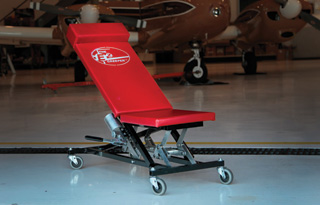 If you work as an aviation maintenance technician or do a lot of your own maintenance, you probably own a creeper—one of those little boards with a bit of foam padding that scoot around on four or six castering wheels.
If you work as an aviation maintenance technician or do a lot of your own maintenance, you probably own a creeper—one of those little boards with a bit of foam padding that scoot around on four or six castering wheels.
It’s hard to imagine that such a simple device could be improved, but when you’re sick of climbing up and down off the floor all day, one starts to consider these things. The Ez Creeper came about for just this reason. Instead of having to constantly get up and down and switch between a creeper and a stool, the Ez Creeper does both. A heavy-duty aluminum frame is connected to the same castering wheels, but from there up the entire design is unique. For one, this creeper is comfortable with quality foam. If the user wants to sit up, he simply works a lever that drives a pump to raise the seat. A few pumps later and the back comes to a maximum of maybe 30 degrees from vertical. Turn a release valve and it collapses back to flat, or anywhere in between.
We passed the Ez Creeper around the airport, getting reactions from local mechanics and owners handy with a wrench. Without exception they all were impressed with the concept and the execution.
The worst part of the Ez Creeper is the price, which is a bit high. But it’s hand-built in Canada using quality components, and it comes with a lifetime warranty. That’s definitely worth something if you spend a bunch of time in shops or active hangars.
Price: $899.99
Contact: www.ezcreeper.com
The top end, in depth
Borescoping the Debonair’s cylinders
By Thomas A. Horne
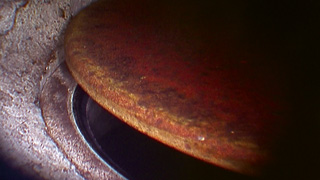 I have good news and bad news. The good news is that when we bought the Debonair Sweepstakes airplane back in the summer of 2012, we inherited an engine with just 140 hours since a major overhaul. The bad news is that that engine had essentially been sitting for the previous five years. Do the math: 140 hours divided by five equals a scant 28 flying hours per year. My guess is that most of those hours were spent flying locally, with plenty of touch-and-goes to stay current.
I have good news and bad news. The good news is that when we bought the Debonair Sweepstakes airplane back in the summer of 2012, we inherited an engine with just 140 hours since a major overhaul. The bad news is that that engine had essentially been sitting for the previous five years. Do the math: 140 hours divided by five equals a scant 28 flying hours per year. My guess is that most of those hours were spent flying locally, with plenty of touch-and-goes to stay current.
So for months on end, the airplane’s engine was stopped. This kept oil from protecting the internal components and allowed moisture to condense on the cylinders’ steel walls. Over time this caused deposits—rust!—to form on those walls. That rust showed up after we gave the airplane its first oil change, and the oil analysis sample showed high levels of iron—a sure marker of wearing steel components. Oil-analysis laboratory Blackstone Labs (www.blackstone-labs.com) sounded a cautionary note, advising us to keep flying the airplane, and change the oil at 10-hour intervals to see if iron levels drop.
Which we did. After all, the engine runs well, its cylinder compressions are good, and the airplane makes book speeds and fuel consumption rates. When the airplane had its interior work done, Air Mod installed an Airwolf remote-mounted oil filter. Its paper element, we hope, will help catch any iron/rust floating around and recirculating in the oil. The ten-hour oil change intervals also would help in flushing out any old iron particles.
But we were curious. How bad could the cylinder walls be? Select Aircraft Service at Ohio’s Clermont County Airport did a borescope exam and the results were somewhat discouraging. There were signs of pitting and wear. But iron levels came down in the second oil analysis report. Maybe the rapid-flush strategy was working, and eventually the engine would be freed of the excessive iron.
The next 10 hours of flying involved two very long cross-country flights of five hours each. Then came a leg of two hours. The extra 40 gallons of fuel provided by the tip tanks let me fly from Clermont County to AOPA Summit at Fort Worth’s Meacham International Airport and back, all the while running the fresh oil through the Airwolf’s conventional paper filter (the engine originally was equipped with an oil screen).
While waiting for the next oil change and oil analysis, we visited Adrian Eichhorn. Eichhorn is an airframe and powerplant mechanic with inspection authorization privileges, an airline first officer, and a well-known Bonanza/Baron/Debonair expert. Eichhorn offered his own borescope inspection—one with a twist. Instead of a conventional borescope, Eichhorn uses a medical endoscope of the kind used by ear, nose, and throat specialists. It provided a huge, high-definition image of the cylinders’ walls, valves, and valve guides—all on a large, flat-screen television monitor.
And the verdict? The valves and valve guides were in excellent condition, with little in the way of lead deposits and no signs of uneven heat concentrations. The cylinder walls, while pitted, were still serviceable. “Based on what I’ve seen, I’d fly this engine across the ocean,” Eichhorn said. While this was a great relief, we’ll still keep up the 10-hour oil-change-and-analysis routine. An inspection of the engine’s “bottom end” (the camshaft, crankshaft, and its bearings and journals) is next.
But don’t worry, all you potential winners out there. Ultimately, we’ll address any and all engine issues before turning they keys over to you. Right now, we’re negotiating with several potential contributors to the cause.
Email [email protected]
Follow Tom Horne’s blog (http://blog.aopa.org/sweepstakes_logbook/) for updates on the renovation, as well as related news.
Three ways to win one of 76 prizes in AOPA’s Debonair Sweepstakes
Join or renew your AOPA membership and you are entered to win in AOPA’s Debonair Sweepstakes. AOPA is giving away a completely restored 1963 Beechcraft Debonair B33 with an all-new ergonomic interior, the latest avionics, and up-to-date airframe as the grand prize. Plus, you could also win one of 75 other great aviation prizes. Visit the website (www.aopa.org/Membership/Sweeps.aspx) to enter.
Best crew car ever?
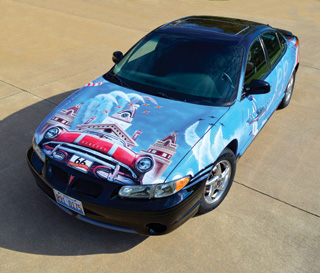 Just 90 minutes southwest of Chicago lies the town of Pontiac, Illinois, squarely on historic Route 66. City fathers have made use of all local resources to draw in the tourists, including the Pontiac Municipal Airport crew car.
Just 90 minutes southwest of Chicago lies the town of Pontiac, Illinois, squarely on historic Route 66. City fathers have made use of all local resources to draw in the tourists, including the Pontiac Municipal Airport crew car.
It’s not a beater as you might expect, but a 2002 Pontiac Grand Prix airbrushed by internationally famous artist Dongbai Tang, who—until he moved to the United States—was a recognized artist in Beijing, China. He established his DongBai International Airbrush Art School in Pontiac and has decorated the town (a sidewalk painting looking like a water-filled hole full of sharks), its cars and trucks, and its people (dress designs that glow under ultraviolet light) ever since.
Dongbai painted the car for the Pontiac Oakland Automobile Museum, which has loaned it to the airport. Route 66 is featured along with aircraft on the car, considering that busloads of international tourists come to Pontiac to see the Route 66 Association Hall of Fame. When you drive the car, you are a rolling ad for the town and for aviation. —AKM
75 years ago this month
AOPA was formed in May 1939.It is January 1939. Franklin Delano Roosevelt is president of the United States. Vice president is John N. Garner. Population of the United States is 130,879,718. A first-class stamp cost 3 cents. One gallon of automobile gas cost 10 cents. Unemployment is at 17.2 percent.
January 1: In his state of the union address, FDR asks Congress to strengthen U.S. air power, calling it “utterly inadequate.”
Hewlett-Packard is founded in California.
January 2: Adolf Hitler is Time magazine’s Man of the Year.
January 5: Amelia Earhart is officially declared dead after her 1937 disappearance.
January 15: First NFL Pro Bowl—the New York Giants beat the All Stars, 13-10.
January 26: Gone With the Wind begins filming.
January 27: First flight of the Lockheed P–38 Lightning.
January 30: Adolf Hitler’s Reichstag speech calling for the “annihilation of the Jewish race.”
January 31: FDR meets with State Military Affairs Committee to discuss policy of selling airplanes to France.



